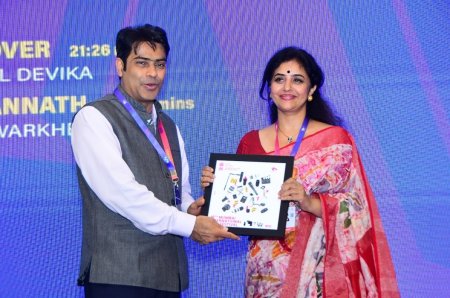
|   |

|   |
Films with a difference - Chandra Anand e-mail: chandra6267@yahoo.co.in July 11, 2024 The 18th Mumbai International Film Festival 2024 was held at NFDC Complex, Cumballa Hill, Mumbai, from 15th to 21st June 2024. In this festival, there was a section of films marked as special package where films with a difference were shown. One such package was the ‘Divyanjan’ package that had been designed in a manner that would allow differently abled persons to watch and enjoy films. There were short films with Indian Sign Language (ISL) and closed captions for the audience with hearing disabilities. And also films with audio description for the visually challenged. The film ‘Crossover’ with dance used the Indian Sign Language. The Mumbai International Film Festival (MIFF) is a landmark event, proudly holding the title of the oldest and largest film festival dedicated to documentary, short fiction, and animation films in South Asia. Organized by the National Films Development Corporation of India (NFDC), the apex body of filmmaking in India, under the Ministry of Information and Broadcasting, MIFF remains a cornerstone of the Indian cultural landscape. Over the past three decades, NFDC has become a nurturing ground for aspiring and established filmmakers who use their craft to make a difference in the world. Taking the effort forward, a dedicated initiative, the ‘Divyanjan’ films, was screened at the 18th MIFF. On 19th June, the films of the Divyanjan package were screened at JB hall, NFDC Complex. It had 4 short films. Two films were from the serial ‘Little Krishna’ directed by Vincent Edwoods and edited by J. V. Varaprasad. The serial ‘Little Krishna’ is a children’s animated show chronicling the adventures of a young Lord Krishna at Vrindavan. The first one, ‘The horror cave’ (episode 3), told the story of Krishna, where the evil uncle of Krishna, Kamsa, sends the demon snake Aghasura to kill Krishna. The second film was ‘The challenge of the brute’ (episode 8), in which the bison like demon Arishtasura was also sent by Kamsa to kill Krishna. There the difference was, in the corner of the screen was seen a lady interpreting the dialogues in ISL - an initiative of India Signing Hands (ISH) , for the Deaf and Hard of Hearing (DHH) community children so that they get to be aware of the spoken dialogues in the story. Next to be screened was ‘Crossover’, a film made by Dr. Methil Devika, who is a Mohiniattam artiste and has a doctorate in the same field. Recipient of national and state awards, she has been empanelled with the ICCR and SPIC-MACAY. Here, in this film, she prepares a presentation to reach out the art form to the DHH community. For this purpose, she blends ISL and the Mohiniattam gestures, to explicate the narrative effectively throughout her performance in Mohiniattam, which presented the story of Lord Krishna's birth.  Methil Devika performing in the film  Audience reaction in the film At first she comperes or interprets the story in ISL to tell the audience of DHH community what she is going to present. When she starts with the actual story presentation through dance performance, she uses the ISL language to explain the lyrics. By this she reduced their hassle of not being able to hear the lyrics sung by the singer. And then proceeded to act out the story of the birth of Krishna by using the dance symbols. One can see at some points, she interspersed the ISL gestures with Hastalakshanadeepika gestures to present the story. Thus, she was able to reach out to the DDH audience, who could then thoroughly enjoy the presentation. Normally all films are scripted frame to frame to make sure that there is proper continuity or link is maintained in the story. But, here through a background narration, we realise that the expressions of the DHH audience are very spontaneous. They have been given no instructions other than to sit and watch the performance done by Devika. We understand from the background commentary given in her own voice that Devika fears there is chance of failure to reach out her presentation effectively to them. But as the narrative of the performance progresses, she sees them responding to her gestures in a positive manner and then the feeling of crossing over to them is felt in the hearts of both audience and the artiste. And finally in an interaction with them after the presentation, which is also filmed, from their shared responses of how they enjoyed the story, we understand how they enjoyed the art form itself. In a brief conversation with the artiste, Devika gives the analogy of finding oneself in a land where one doesn’t speak their language and experiences the inability to communicate. Thus when we learn ISL, the DHH community too become able. Thus seamlessly merging and integrating functionality of the ISL with aesthetics of gesture language of dance into a newly altered gesture language is perhaps what helped the crossover to the side of the DHH community. By this act of reaching out with an adapted language, perhaps Devika has given a methodology, by which artistes can present classical dance and bring the DHH community to understand gestures in a better manner and enjoy classical dance performances in a holistic manner. The fourth film by Shripad Warkhedka and edited by J. V. Varaprasad, was specifically made for the visually challenged. It had two stories. First was ‘Jay Jagannath’ which presented the story of two friends - one was a little boy Balaram and the other was the Lord Jagannath of Puri himself. This series explores their adventures and incorporates folktales, blending mythology and friendship narratives. The second story was about the birth of Garuda and his life situations. The audience was given blindfolds to experience the special audio descriptions. The sound was specially engineered or amplified in such a manner for the visually challenged to have better experience of hearing a story presented in audio format with dialogues.  Festival Director, MIFF, Prithul Kumar felicitates Methil Devika The special event was graced by notable figures including Alok Kejriwal, Founder & CEO of India Signing Hands (ISH); Brij Kothari, Faculty at IIT Delhi; Abraham Uthup, Senior VP at Toonz Media; Dr.Methil Devika, dancer & researcher; Prithul Kumar, Festival Director & Joint Secretary, Broadcasting, Ministry of Information and Broadcasting; and Sreerag M, Officer on Special Duty, Films, Ministry of Information and Broadcasting. More than 50 students from Sanskar Dham Vidyalaya and Victoria Memorial School for the Blind attended the special screening, giving an overwhelming response to the films showcased. Thus, through Divyanjan package one came to know about the efforts made by the people working with the disabled community to make them enjoy this medium of art. Alok Kejriwal, Founder of India Signing Hands, appreciated the efforts taken by NFDC and the MIFF team to sensitise and train volunteers to help the disabled community to go around comfortably in the complex and have an in-house experience of these films.  Chandra Anand is a Bharatanatyam artiste and teacher. She has an MA in Bharatanatyam from Tilak Maharashtra Vidyapeeth, and her series on 'Education in spiritual values through Bharatanatyam' is featured in narthaki.com. |